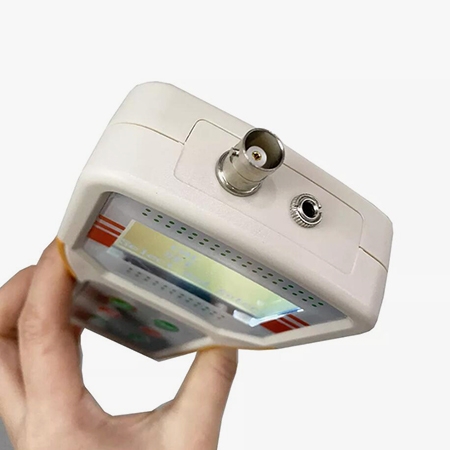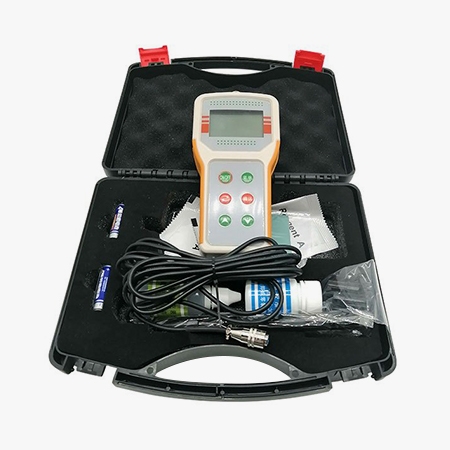The conductivity meter adopts a handheld design that can meet the measurement of various liquid conductivity. Using a 9V battery, it is easy to install and replace and easily solves the power supply problem.

Complete Functions
- The AC voltage generated by the oscillator is applied to the electrode, and the current is generated in the conductivity cell. After temperature compensation and other methods, it is converted into a digital signal by the A/D converter and displayed by the microcomputer.
- It can measure a variety of liquids. When equipped with a 0.1 specification constant electrode, it can measure the conductivity of pure water or high-purity water.

Easy to Operate
- The battery design is easy to carry and does not require an external power supply. It is suitable for on-site rapid testing needs.
- Small size, lightweight, can be calibrated most easily and improves work efficiency.
- Equipped with a backlit display, it can operate smoothly even in low-light or dark environments.
Applications
sisco conductivity meter, an intelligent online chemical analyzer, is widely applied for continuous monitoring and measurement of EC value or TDS value or ER value and temperature in the solution in the industry of thermal power, chemical fertilizer, environmental protection, metallurgy, pharmacy, biochemistry, food and water, etc.

| Model | SISCO-CDTYM-DDL1B | |||
| Measuring Range | (0~1999)μs/cm | (200~1999)μs/cm | (2.00~19.99)μs/cm | (20.0~199.9)μs/cm |
| Resolution | 0.1μs/cm | 1μs/cm | 0.01ms/cm | 0.1ms/cm |
| Accuracy | ±1.0%FS (Electricity Meter) | |||
| ±1.5%FS (Packages) | ||||
| Manual Temperature Compensation Range | 10~50℃ | |||
| Battery power | 9V | |||
| Temperature Coefficient | 2.0%/℃ | |||
Q1: What is a conductivity meter?
The conductivity meter is mainly an instrument for measuring the current capacity of the liquid medium. They are generally used for continuous monitoring of conductivity values in electric power, the chemical industry, metallurgy, environmental protection, pharmaceuticals, fields, lakes, scientific research, food and tap water, as well as in water treatment and aquaculture experiments.
Q2: How does a conductivity meter work?
Conductivity Meter Principle Conductivity is a numerical representation of the ability of a solution to conduct electrical current. The conductivity of water has a certain relationship with the number of inorganic acids, alkalis and salts contained in the water. When their concentrations are low, the conductivity increases with the increase of the concentration. Therefore, this indicator is often used to infer the total concentration or salinity of ions in water. Conductance (G) is the inverse of resistance (R). As a result, when two electrodes (usually platinum or platinum black) are inserted into the solution, the resistance R between the two electrodes can be measured. According to Ohm's law, the resistance value is proportional to the electrode spacing L (cm) and inversely proportional to the electrode's cross-sectional area a (cm2 ).
Q3: What is a conductivity meter used for?
- Water quality monitoring: The conductivity is affected by salt, inorganic acid, alkali, etc. in the water, so the higher the conductivity, the higher the concentration in the water will be reflected, the total concentration and salt content of ions in the water can be understood, and the purity of the water quality and due to the control of the production process, the conductivity of the water will vary with the TDS content in the water.
- Electroplating solution: Conductivity is an important parameter reflecting the electroplating solution. It can reduce the voltage in the electroplating bath and improve the dispersion ability of the electroplating solution. The conductivity of the electroplating solution can be reflected by measuring the conductivity.
- Atmospheric monitoring: The conductivity meter is used in atmospheric monitoring mainly for pollutants contained in the atmosphere such as carbon monoxide, sulfur dioxide, carbon dioxide and various nitrogen oxides. It can pass the gas absorption device and pass the gas through the absorption liquid to check the change of conductivity and monitor exceeding the standard in the polluted area
Tips: Solutions to Common Problems of Conductivity Meters
As a commonly used water quality testing equipment, conductivity meters may encounter various problems in daily use. In response to these problems, we can take a series of measures to solve them, such as regular cleaning and replacement of electrodes, checking power supplies and circuit boards, and proper storage and use of electrodes. Through these methods, the measurement accuracy and stability of the conductivity meter can be effectively improved to ensure the accuracy of water quality testing. At the same time, when using the conductivity meter, users should also pay attention to exposing the electrodes to the air to avoid contamination and pay attention to the water sample collection process to avoid contamination or dilution of the water sample. If you encounter a problem that cannot be solved, you should contact the after-sales service department in time for further consultation or repair.
Thank you for buying industrial test and measurement equipment on SISCO.com, all products sold by SISCO and the partner cover a 12 months warranty, effective from the date of receiving the products.
What is covered?
SISCO is responsible for providing free spare parts, and free technical support to assist the customer to repair the defective products until the problem is solved.
What is not covered?
- Product purchased from anyone other than a SISCO store or a SISCO authorized reseller.
- Expendable parts.
- Routine cleaning or normal cosmetic and mechanical wear.
- Damage from misuse, abuse or neglect.
- Damage from use of parts other than SISCO approved.
- Damage from use outside the product’s usage or storage parameters.
- Damage from use of parts not sold by SISCO.
- Damage from modification or incorporation into other products.
- Damage from repair or replacement of warranted parts by a service provider other than a SISCO authorized service provider.
- Damage caused by the application environment not meeting the product usage requirements and the failure to perform preventive maintenance.

